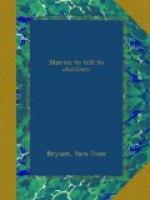A remarkably good example of the type of humorous story to which these principles of method apply, is the story of Epaminondas on page 92. It will be plain to any reader that all the several funny crises are of the perfectly unmistakable sort children like, and that, moreover, these funny spots are not only easy to see; they are easy to foresee. The teller can hardly help sharing the joke in advance, and the tale is an excellent one with which to practise for power in the points mentioned.
Epaminondas is a valuable little rascal from other points of view, and I mean to return to him, to point a moral. But at the moment I want space for a word or two about the matter of variety of subject and style in school stories.
There are two wholly different kinds of story which are equally necessary for children, I believe, and which ought to be given in about the proportion of one to three, in favour of the second kind; I make the ratio uneven because the first kind is more dominating in its effect.
The first kind is represented by such stories as The Pig Brother,[1] which has now grown so familiar to teachers that it will serve for illustration without repetition here. It is the type of story which specifically teaches a certain ethical or conduct lesson, in the form of a fable or an allegory,—it passes on to the child the conclusions as to conduct and character, to which the race has, in general, attained through centuries of experience and moralising. The story becomes an inescapable part of the outfit of received ideas on manners and morals which is a necessary possession of the heir of civilisation.
Children do not object to these stories in the least, if the stories are good ones. They accept them with the relish which nature seems ever to have for all truly nourishing material. And the little tales are one of the media through which we elders may transmit some very slight share of the benefit received by us, in turn, from actual or transmitted experience.
The second kind has no preconceived moral to offer, makes no attempt to affect judgment or to pass on a standard. It simply presents a picture of life, usually in fable or poetic image, and says to the hearer, “These things are.” The hearer, then, consciously or otherwise, passes judgment on the facts. His mind says, “These things are good”; or, “This was good, and that, bad”; or, “This thing is desirable,” or the contrary.
The story of The Little Jackal and the Alligator (page 100) is a good illustration of this type. It is a character-story. In the naive form of a folk tale, it doubtless embodies the observations of a seeing eye, in a country and time when the little jackal and the great alligator were even more vivid images of certain human characters than they now are. Again and again, surely, the author or authors of the tales must have seen the weak, small, clever being triumph over the bulky, well-accoutred, stupid adversary. Again and again they had laughed at the discomfiture of the latter, perhaps rejoicing in it the more because it removed fear from their own houses. And probably never had they concerned themselves particularly with the basic ethics of the struggle. It was simply one of the things they saw. It was life. So they made a picture of it.




